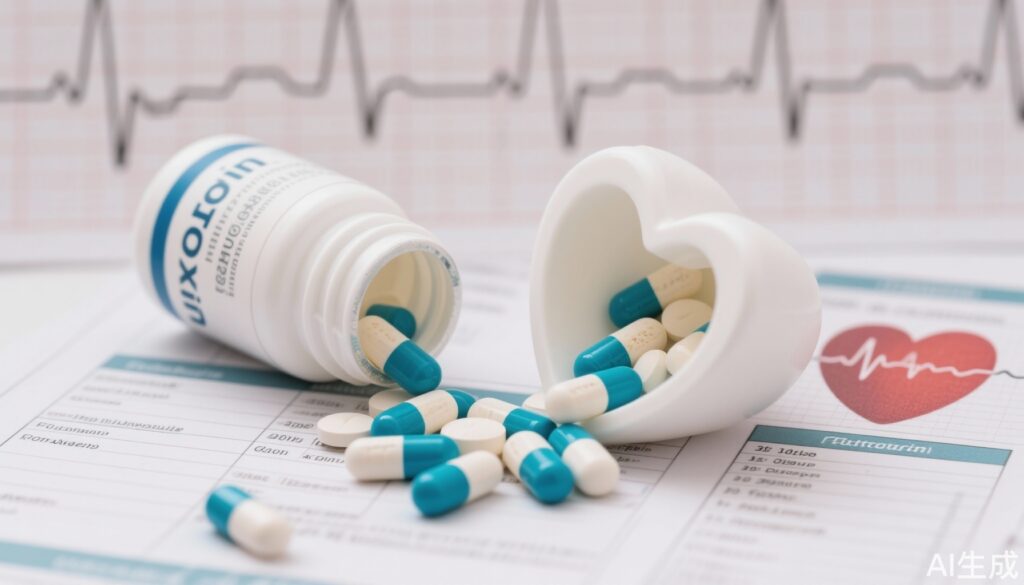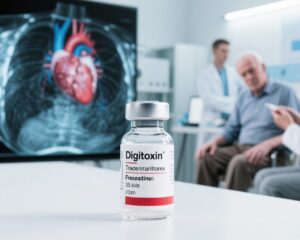Highlight
Low-dose digitoxin added to guideline-directed medical therapy (GDMT) significantly lowered hospitalization and all-cause mortality in symptomatic heart failure patients with reduced ejection fraction (HFrEF). The DIGIT-HF trial demonstrated safety and efficacy in a population with high symptom burden when serum digitoxin concentrations were carefully titrated between 8 and 18 ng/mL. This supports a reconsideration of cardiac glycosides like digitoxin as adjunctive therapy in selected HFrEF patients.
Study Background and Disease Burden
Heart failure with reduced ejection fraction (HFrEF) poses a significant clinical challenge worldwide due to high morbidity, frequent hospitalizations, and substantial mortality despite advances in pharmacotherapy. Contemporary guideline-directed medical therapy (GDMT), which includes agents such as angiotensin receptor–neprilysin inhibitors (ARNi), beta-blockers, mineralocorticoid receptor antagonists, and sodium-glucose cotransporter-2 inhibitors (SGLT2i), has improved outcomes but leaves many patients persistently symptomatic with poor prognosis.
Historically, cardiac glycosides such as digoxin and digitoxin were foundational treatments in heart failure, acting through positive inotropic effects and modulation of neurohormonal pathways. However, concerns over narrow therapeutic windows, toxicity, and conflicting mortality data have led to their reduced use. The renewed clinical question revolves around whether low doses of cardiac glycosides, particularly digitoxin, can safely confer clinical benefit when added to optimized modern therapy.
Study Design
DIGIT-HF was a phase 4, randomized, double-blind, placebo-controlled trial conducted at 65 European centers enrolling 1212 patients with symptomatic HFrEF (left ventricular ejection fraction ≤40%). Participants were randomized to receive low-dose digitoxin or placebo on top of optimized GDMT.
Digitoxin was administered initially at 0.07 mg once daily, with dose adjustments at 6 weeks targeting serum concentrations between 8 and 18 ng/mL. The primary endpoint was a composite of all-cause mortality or hospitalization due to worsening heart failure. Median follow-up was 36 months.
Key Findings
DIGIT-HF demonstrated a statistically significant benefit of digitoxin over placebo in reducing the primary composite endpoint:
– The primary outcome occurred in 39.5% of patients on digitoxin (12.8 events per 100 patient-years) versus 44.1% on placebo (15.7 events per 100 patient-years), corresponding to a hazard ratio (HR) of 0.82 (95% CI, 0.69–0.98; P = 0.03).
– All-cause mortality was reduced to 27.2% (7.8 deaths per 100 patient-years) in the digitoxin group versus 29.5% (8.9 deaths per 100 patient-years) with placebo; HR 0.86 (95% CI, 0.69–1.07), though this was not statistically significant.
Patients enrolled had a high symptomatic burden, with 70.4% classified as New York Heart Association (NYHA) class III or IV, a higher proportion of advanced heart failure than seen in recent large outcome trials such as PARADIGM-HF, DAPA-HF, and EMPEROR.
Notably, many patients were not on the full complement of contemporary GDMT: less than 40% were receiving ARNi, and fewer than 20% were receiving SGLT2i therapy, reflecting either tolerability issues or treatment gaps.
The number needed to treat (NNT) with digitoxin to prevent one primary outcome event (death or hospitalization) was 22, consistent with effect sizes observed in other heart failure pharmacotherapy trials despite the advanced patient population.
Safety Findings
Digitoxin was generally well tolerated. The incidence of serious cardiac arrhythmias was lower in the digitoxin group (3.4%) compared to placebo (11%). Discontinuation rates were comparable between groups (9.1% with digitoxin versus 10.2% with placebo).
Importantly, serum digitoxin concentrations remained stable over time and did not require frequent dosage adjustments, even in patients with renal impairment, enhancing the ease of clinical use.
Expert Commentary
Dr. Udo Bavendiek, lead investigator from Hannover Medical School, emphasized that the trial’s data provide robust support for the efficacy of digitoxin at low serum levels, distinguishing its therapeutic window from earlier concerns surrounding higher doses that were associated with harm.
American Heart Association spokesperson Dr. Gregg Fonarow acknowledged the findings as potentially practice-changing, noting the unmet need for additional treatment options in symptomatic HFrEF patients who remain inadequately controlled despite GDMT. He highlighted the importance of careful patient selection and adherence to dosing guidelines to maximize benefit and safety.
While the DIGIT-HF trial addresses important gaps, it also has limitations including partial GDMT implementation among participants and exclusion of patients unable to tolerate cardiac glycosides. Further real-world studies and subgroup analyses may clarify the role of digitoxin among diverse heart failure populations.
Conclusion
The DIGIT-HF trial revives interest in digitoxin as a valuable adjunct therapy for patients with symptomatic HFrEF, demonstrating improvements in clinically meaningful outcomes with low-dose treatment on top of standard therapies. The trial’s rigorous dosing strategy underscores the critical importance of maintaining serum digitoxin within a therapeutic window to ensure safety. Given the persistent morbidity and mortality in HFrEF despite current treatments, digitoxin offers a promising addition to the therapeutic armamentarium for carefully selected patients.
Future guideline updates may incorporate these findings, advocating digitoxin use in patients intolerant or refractory to full GDMT. Clinicians should remain vigilant regarding dosing and monitoring to optimize patient outcomes while minimizing risks.
References
Bavendiek U, Großhennig A, Schwab J, et al; DIGIT-HF Study Group. Digitoxin in Patients with Heart Failure and Reduced Ejection Fraction. N Engl J Med. 2025 Aug 29. doi:10.1056/NEJMoa2415471. Epub ahead of print. PMID: 40879434.
Ponikowski P, Voors AA, Anker SD, et al. 2021 ESC Guidelines for the diagnosis and treatment of acute and chronic heart failure. Eur Heart J. 2021;42(36):3599-3726. doi:10.1093/eurheartj/ehab368.
McMurray JJ, Packer M, Desai AS, et al. Angiotensin–Neprilysin Inhibition versus Enalapril in Heart Failure. N Engl J Med. 2014;371(11):993-1004. doi:10.1056/NEJMoa1409077.
Wiviott SD, Raz I, Bonaca MP, et al. Dapagliflozin in Patients with Heart Failure and Reduced Ejection Fraction. N Engl J Med. 2019;381(21):1995-2008. doi:10.1056/NEJMoa1911303.



